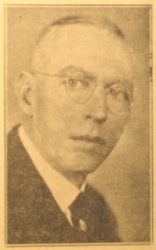Peterson, Charles Augustus
by Biff Hollingsworth and Tim West, Special Collections at Wilson Library at the University of North Carolina at Chapel Hill, 2008. Additional research by T. Mike Childs, 2014.
1882-1960
 Dr. Charles Augustus Peterson, physician and member of the North Carolina House of Representatives and later state senator in the 1920s, 30s and 40s was instrumental in North Carolina's switch from electrocution and hanging to the use of the gas chamber for the execution of condemned criminals. Peterson was born in Relief in Mitchell County in 1882 to Solomon and Julia Edwards Peterson.
Dr. Charles Augustus Peterson, physician and member of the North Carolina House of Representatives and later state senator in the 1920s, 30s and 40s was instrumental in North Carolina's switch from electrocution and hanging to the use of the gas chamber for the execution of condemned criminals. Peterson was born in Relief in Mitchell County in 1882 to Solomon and Julia Edwards Peterson.
Peterson attended Bowman Academy in Bakersville, Dwight Institute in Erwin, Tennessee, the Tennessee Medical College from 1903 to 1906, and received his medical degree from the North Carolina Medical College in 1907.
Little is known about his life prior to coming to Raleigh to serve as a lawmaker, save for the fact that he was previously a physician from Spruce Pine (Mitchell County). Dr. Peterson served his first term in the House of Representatives from 1923-1924. A decade later, in 1935, he returned, this time with "the announced intention of attempting to substitute lethal gas for the electric chair." He did just that. Within months of his 1935 election, Peterson introduced a bill to change the state's official execution method to lethal gas. The Raleigh News and Observer characterized the bill as "his pet project." In her article "The Killing Chair: North Carolina's Experiment in Civility and the Execution of Allen Foster," historian Trina Seitz states, "Although Dr. Peterson's motive for advocating lethal gas is largely speculative, his medical background may have greatly influenced his dedication to this issue...the News and Observer noted that Peterson had apparently been corresponding with the wardens of two western penitentiaries, inquiring as to their success in using lethal gas and whether the wardens believed the method was 'effective'."
In March 1935, the Joint Committee on Penal Institutions reviewed Dr. Peterson's lethal gas bill. The committee heard testimony from other physicians and dentists who had "considerable experience with anesthetics." The speakers all testified that lethal gas was a more humane method of execution than electrocution. Following the hearing, the committee concluded that the bill should be sent to the floor of the House for a formal vote. The bill was passed by the House and sent to the Senate. The North Carolina Senate voted unanimously on 1 May 1935 to replace electrocution with lethal gas. By December 1935, a lethal gas chamber had been erected inside the walls of Central Prison in Raleigh, N.C. The installation was seen as a technological innovation, an advance that was met with great optimism by state officials and citizens alike. However, all did not go as planned. Mistakes were made in the gas chamber's first use, the execution of Allen Foster, which forced North Carolinians to face the sometimes gruesome business of capital punishment.
Peterson married Nora McCall in 1908. Peterson was a Republican, a Freemason, and a member of the Knights of Pythias. He was president of the Bank of Spruce Pine from 1916 to 1922. Peterson was a member of the North Carolina State Medical Society, the Southern Medical Association, the American Medical Association, and was president of the Mitchell County Medical Society. He died in 1960.
References
House, R. B., compiler and editor. "Charles Augustus Peterson." North Carolina Manual 1923. Raleigh [N.C.]: Edwards & Broughton Printing Company. 1923. 497. https://archive.org/details/northcarolinaman1923nort/page/496/mode/2up?view=theater
London, H. M., compiler and editor. "Charles Augustus Peterson." North Carolina Manual 1935. Raleigh [N.C.]: Legislative Reference Library. 1935. 186. https://archive.org/details/northcarolinaman1935nort/page/186/mode/2up?view=theater
Additional Resources:
Christianson, Scott. "North Carolina's gas chamber years." July 2, 2010. (accessed May 2, 2014).
Spruce Pine Planning Board; Western North Carolina Regional Planning Commission. Population & economy, Spruce Pine, North Carolina. [Spruce Pine, N.C.]: The Board. 1965. 4. https://archive.org/details/populationeconom00spru/page/n15/mode/2up?view=theater (accessed May 2, 2014).
North Carolina General Assembly. Journal of the House of Representatives of the General Assembly of the State of North Carolina 1935. Raleigh, N.C. [N.C.]: M.S. Littlefield,1869-. 1935. https://digital.ncdcr.gov/Documents/Detail/journal-of-the-house-of-representatives-of-the-general-assembly-of-the-state-of-north-carolina-...-1935-session/3833882 (accessed May 2, 2014).
"An Act to Amend Sections Four Thousand Six Hundred Fifty-Seven and Four Thousand Six Hundred Fifty-Eight of the Consolidated Statutes Substituting Death by Administration of Lethal Gas for Death By Electrocution in North Carolina." Public laws and resolutions passed by the General Assembly at its session of 1935. Charlotte [N.C.]: The Observer Printing House. 1935. 321-322. https://digital.ncdcr.gov/Documents/Detail/public-laws-and-resolutions-passed-by-the-general-assembly-at-its-session-of-...1935/4113812?item=4118784 (accessed May 5, 2014).
Biddix, David, and Chris Hollifield. Spruce Pine. Charleston, S.C.: Arcadia Publishing. 2009. 9, 15, 19-24, 120. http://books.google.com/books?id=5xyAi27fKhMC&pg=PA22#v=onepage&q&f=false (accessed May 5, 2014).
Christianson, Scott. The Last Gasp: The Rise and Fall of the American Gas Chamber. Berkeley: University of California Press. 2010. 108, 111, 113. http://books.google.com/books?id=AIzaoHoggUwC&pg=PA108#v=onepage&q&f=false (accessed May 5, 2014).
Sheppard, Muriel Earley. Cabins in the Laurel. Chapel Hill: University of North Carolina Press. 1991. 130. http://books.google.com/books?id=gQFVwW-msEkC&pg=PA130#v=onepage&q&f=false (accessed May 5, 2014).
Journal of the House of Representatives of the General Assembly of the State of North Carolina Session 1935. Raleigh, N. C.: Edwards & Broughton Company, State Printers. 1935. 956. https://digital.ncdcr.gov/Documents/Detail/journal-of-the-house-of-representatives-of-the-general-assembly-of-the-state-of-north-carolina-...-1935-session/3833882 (accessed May 5, 2014).
Kotch, Seth. "Capital punishment in North Carolina, 1910-1936." Master's thesis, University of North Carolina at Chapel Hill, 2005. (accessed May 5, 2014).
Seitz, Trina. "The Killing Chair: North Carolina's Experiment in Civility and the Execution of Allen Foster." North Carolina Historical Review 81, no. 1 (January 2004): 38-72.
Image Credits:
"Circa 1935: Dr. Charles Peterson (Photograph from the Raleigh News & Observer, May 1935)." Photograph. Special Collections at Wilson Library at the University of North Carolina at Chapel Hill. https://ncpedia.org/capital-punishment (accessed May 5, 2014).
1 January 2008 | Childs, T. Mike; Hollingsworth, Biff; West, Tim